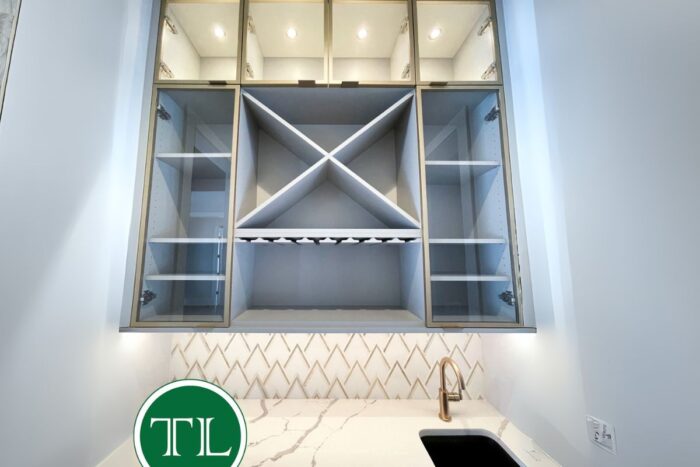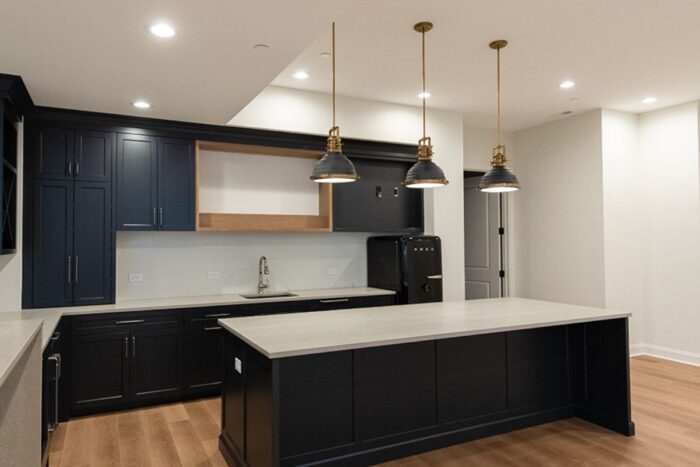Creating a personal wine cellar is a dream of every wine enthusiast and an intelligent step for high-end homeowners. A beautifully designed wine room doesn’t merely keep bottles – it safeguards your investment and is a stunning piece of display in your residence. Indeed, real estate professionals find that in ultra-high-end markets (homes priced above $5 million), a wine cellar is nearly mandatory. But even if you’re not in that budget, a well-thought-out wine cellar can be a stylish addition and an investment.
Keep reading for our helpful guide – from selecting wine cellar racks to nailing the right lighting so you can create a cellar that’s as functional as it looks.
Choosing the Right Wine Cellar Racks
Your wine cellar racks are the building blocks of your design – they contain your bottles and establish the mood. Consider them a closet for your wine: they must be stylish and protect bottles. To evoke a traditional atmosphere, a wooden wine cellar with dark oak is like a library for wine. Wood insulates naturally and appears warm, particularly with crown moldings. Reds and browns of wood suit bottle labels, and strong woods (redwood, oak, mahogany) do not succumb to moisture and can last decades.
Meanwhile, metal racks (aluminum or stainless steel) provide you with that slim, contemporary appearance. Metal does not warp when exposed to humidity, and most metal designs feature bottles label-forward on the wall for a super-contemporary look. Consider a stainless steel grid that make the collection stand out. You may even mix materials – such as a wood frame with metal accents or glass shelves. The key is to choose racks that are rock-solid (wine can get heavy) and, if possible, modular – that way your cellar can grow with your collection.
Here are a few rack options to spark your imagination:
- Floor-to-ceiling built-ins: Maximize storage with tall wood or metal racks that use every inch of height. Add trim for a polished look.
- Diamond bin shelving: These X-shaped compartments let you stack cases on their side. It’s great for bulk storage (like homewine or gift sets) and adds visual interest.
- Wall-mounted displays: Floating shelves, cable racks, or metal pegs on a wall can save floor space and turn a wall into art. Many labels-forward metal systems use LED backlights to make bottles glow.
- Modular cube units: Individual cubbies or stackable cubes give flexibility. You can reconfigure them over time and even find inserts for stemware or decanters.
- Pull-out cradles and drawers: Consider a sliding shelf or rotating corner rack for hard-to-reach bottles. These protect your most precious vintages and make grabbing a bottle easy (no wobbly step stools needed).
No matter what style you choose, think ahead: heavier bottles require solid support. And don’t forget that some custom racks can be designed to accommodate glasses or even a small tasting table as an inset, making the cellar even more functional.
Creative Wine Cellar Shelving Ideas

Beyond traditional racks, other wine cellar shelving ideas can make your cellar distinctive and effective. Be creative to incorporate personality and smart storage:
- Glass-front cabinets or lockers: Display special bottles behind glass doors. LED lighting inside will make them sparkle.
- Wine cork or barrel-top counters: If you include a tasting island or table, incorporate wine-inspired materials. Perhaps a countertop infused with restored corks or a refinished barrel stave slab will be a great conversation starter.
- Stemware racks and niches: Incorporate hanging racks under shelves or little cubbies for glasses. This keeps everything handy for tasting sessions.
- Under-stair or corner cradles: Don’t waste odd-shaped spaces. A custom corner rack or waterfall design can flow with your cellar’s architecture.
- Integrated barrels or barrels as bases: Some people use real wine barrels cut in half as side tables or pedestal racks – it adds rustic charm in a modern or traditional cellar.
By combining and supplementing these concepts, you can customize your storage. As Tom Len says, the choices are limitless – make it work, but not without letting your personality come through.
Lighting and Ambiance

Good light is important for both wine maintenance and ambiance. You want sufficient light to read labels, but you certainly don’t want UV rays warming your Cabernet. The solution? Properly done wine rack lighting, usually with LEDs. LEDs are energy-efficient, produce virtually no UV, and remain cool (key – heat ages wine!). In fact at Tom Len Custom Homes, we advise dimmable LED bulbs as the safest option.
Employ LED accent lighting to give your collection that wow factor. For instance, place LED strip lighting along the bottom of each shelf so that every bottle is lit up from underneath. Backlighting a glass-case section or a rack wall creates a show-stopping glow – the light passes through the bottles and gives your cellar the aura of an upscale tasting room.
The objective is layers of warm light: ambient overhead lighting, supplemented by specific accents on the shelves and showcases. Don’t use fluorescents or naked bulbs. Instead, consider recessed lighting, wall washers, or LED tape concealed in trim. All these guarantee your wine is secure (no light-struck defects) and your cellar is beautiful.
Temperature, Humidity, and Preservation
Beneath the aesthetics, the most critical task of your cellar is safeguarding the wine. You want it to be a chilly wine cave. Your target temperature should be steady 55°F (approximately 13°C). Too hot (above ~70°F) and wine can “cook” – aging much quicker and inconsistently. Maintain it steady, and your reds, whites, and fizz will age gradually into full-bodied, sophisticated flavors.
Humidity needs to be between 60–70%. This prevents corks from drying out (dry corks admit oxygen, ruining the wine). Too much humidity, however, and you can expect mold or rotting labels. A humidifier/dehumidifier built into your refrigeration maintains this level.
A well-known experiment illustrates why this is important: researcher Dr. Fulvio Mattivi put 400 bottles of wine – half in a commercial cellar (15–17°C) and half in an ordinary house closet (20–27°C). Two years later, the closet wines had aged four times as fast and lost most of their color and antioxidant compounds relative to the cellar wine. Simply stated, climate control is science.
Here are some quick rules to keep your wines happy:
- Temperature: ~55°F (choose 50–65°F range). Use a reliable wine cooling system if your house can’t maintain that on its own.
- Humidity: ~60–70%. Consider a digital hygrometer or a built-in cellar humidifier.
- Orientation: Store bottles horizontally so the wine stays against the cork. (This keeps the cork moist.) Screw-caps can be upright, but there’s no harm in laying them down, too.
- Darkness: Shield from bright sunlight. Even the colored bottles in the store don’t block UV completely; a sunny wall can “light-strike” your wine. Utilize dimmable lights, and blackout doors or curtains if necessary.
- Vibration: Leave it still. Don’t locate the cellar next to a washer/dryer or heavy machinery that shakes. Ongoing vibration can upset sediments and play havoc with aging.
Adhering to these tips will make your wine taste better for decades. What’s the use of having a gorgeous cellar if the wine stored there is bad, after all?
A Space to Enjoy (Seating, Tables, and Extras)
Remember: a wine cellar is also a gathering spot. If there is room, add a tiny tasting space. This may be as straightforward as a built-in marble shelf or a circular table with a couple of chairs. One design tip is to integrate a “tasting table” shelf into the racks – pull it out when it’s time to sample a bottle. Some cellars have a cozy banquette or bar stools facing a glass wall of wine; others even have full dining tables if they’re large enough.
Whatever you opt for, make it welcoming. A stone or quartz countertop resists spills and corkdirt. Plush seating (perhaps upholstered in leather or velvet) makes your cellar a living room in which friends can lounge. Pendant lighting from above or a tiny chandelier (once more, LED-compliant) can create ambiance. And don’t overlook the details: stemware holders, a decanter cabinet, or even a cart to wheel in extra bottles.
A dedicated tasting space encourages conversation and makes the wine experience more pleasant. That is, treat it as a mini wine bar or cozy dining corner. After all, it needs to reflect your personality – perhaps rustic, sleek, or somewhere in between – and make wine time special.
Doors, Security, and Practical Details
Finally, think about the nuts and bolts. Select a well-sealed cellar door (glass, metal, or wood) to contain the climate within. Glass doors are beautiful and allow you to see a glimpse of the collection, but make sure it’s insulated and UV-blocking. With kids or inquisitive visitors present, a lock is a great idea. You want to protect those rare bottles (and perhaps your peace of mind) from wandering hands. Some dedicated collectors even install a security system or camera.
Think about the placement of your cellar: basements are naturally cool and vibration-free, so they’re the most popular choice. If you put it in the main floor, you’ll most certainly require a special solution for ventilation. Wrap walls with vapor barriers, and steer clear of ventilation grates that would cause temperature disruptions. Floors must be stone, tile or sealed wood (no carpeting – it can become damp and mildewed). The goal is to balance fantasy and function – your ultimate wine cellar is one in which you can grab a bottle, pour a glass, and sit back without giving it a second thought.
Let’s Get Started
Wine cellar design is a little subjective. Prioritize what you care most about – storage space, flair, tasting enjoyment, or all. By blending good wine-storage science (good temp/humidity), beautiful design (nice wooden racks or innovative shelving), and considerate details (lighting, seating, trim), you’ll have a cellar that’s yours alone.
At Tom Len Custom Homes, we think the finest cellars are story tellers—about the vintages you’ve amassed, the gatherings you’ll host, and the peaceful moments you’ll enjoy with a glass in hand. So, if you’re ready to make those wine cellar shelving ideas come alive, let’s talk.
FAQ of Wine Cellar Shelving Ideas
Luxury wine storage ideas include climate-controlled cellars, modern glass wine walls, custom-built cabinetry, LED backlighting, and even hidden wine rooms. These designs can be styled to match contemporary, rustic, or transitional interiors.
It starts with choosing the right location—like a basement, kitchen wall, or entertaining area. Work with your builder to ensure proper insulation, temperature control, and design features that complement the home’s overall aesthetic.
Not at all. While basements are ideal for natural insulation, many homeowners now install wine rooms under stairs, behind glass walls, or as part of dining or lounge spaces.
Most wines should be stored between 55°F and 58°F, with humidity levels around 60%–70%. Installing a cooling system is essential to maintain these conditions in your wine room.
Absolutely! Many luxury homeowners combine storage with seating, adding tasting counters, mood lighting, and décor to create an immersive wine experience right at home.

